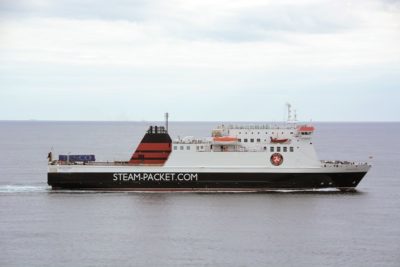
INTER-WAR YEARS
In 1920, the Chairman of the company was C.T.W.Hughes-Games with a Board of six directors living on the island or in the areas around the Mersey. Douglas received passengers, and Ramsey, Castletown, Port St. Mary, Laxey and Peel cargo from a fleet of thirteen vessels, eleven passenger vessels and two small cargo ships. The passengers and cargo were booked by agents in the following ports:-
- Belfast W.E. Williams and Company on Donegal Quay
- Blackpool H. A. Deakin of Talbot Chambers
- Glasgow Rennie and Watson of Robertson Street
- Greenock William Lindsay and Company of Cathcart Street
- Liverpool Thomas Orford and Son of Drury Buildings in Water Street
- Ramsey James Bell of the IOM Steam Packet Office
- Whitehaven G. Nelson and Sons of Lowther Street
The Liverpool cargo loading berths were in the Coburg Dock, with the two cargo ships using a south east corner berth in this dock. The Pierhead at Liverpool was the main berth of the passenger steamers. The caterers for the galleys of the steamers were Heron and Brearley Ltd. of Douglas, and the Head Office of the company was in the Imperial Buildings in Douglas. The two cargo ships were Cushag of 223 grt built in1908, and Tyrconnel of 276 grt built in 1892, with the eleven passenger steamers including replacements for vessels lost in the war or not returned by the Government:-
- Douglas (3) of 774 grt with accommodation for 506 passengers.
- Fenella of 563 grt with accommodation for 504 passengers.
- King Orry (3) of 1,877 grt with accommodation for 1,600 passengers.
- Manxman (formerly of Midland Railway) of 2,091grt with accommodation for 2,020 passengers.
- Mona (4) (ex Hazel) of 1,241 grt with accommodation for 1,241 passengers.
- Mona’s Isle (4) (ex Onward) of 1,688 grt with accommodation for 1,620 passengers.
- Mona’s Queen (2) of 1,559 grt with accommodation for 1,465 passengers.
- Peel Castle of 1,474 grt with accommodation for 1,225 passengers.
- Snaefell (4) (ex Viper) of 1,712 grt with accommodation for 1,700 passengers.
- Tynwald (3) of 937 grt with accommodation for 901 passengers.
- Viking of 1,951 grt with accommodation for 1,951 passengers.
Total passenger complement of this fleet was thus almost 15,000 passengers.
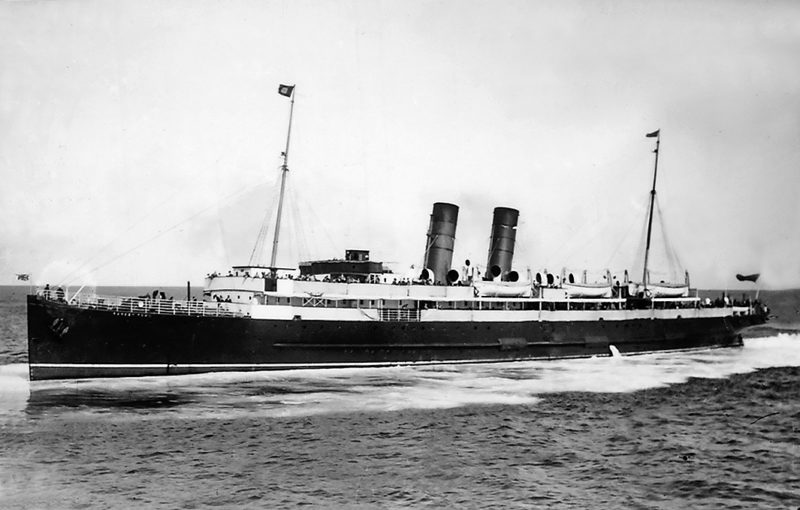
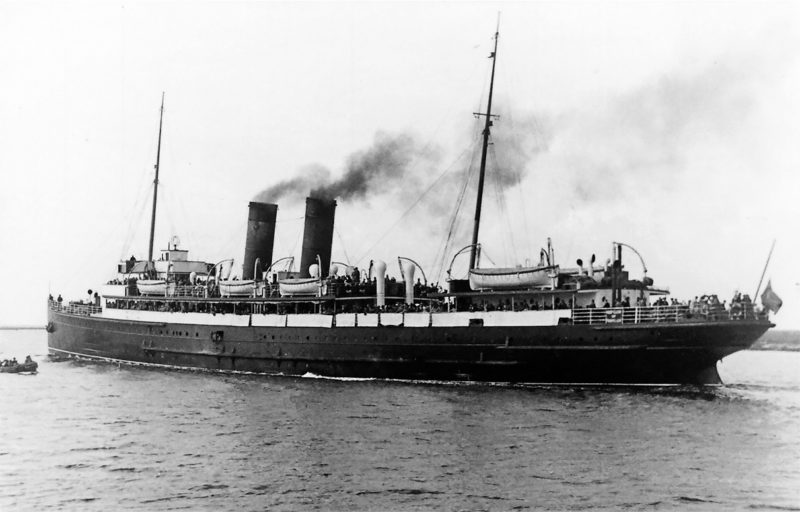
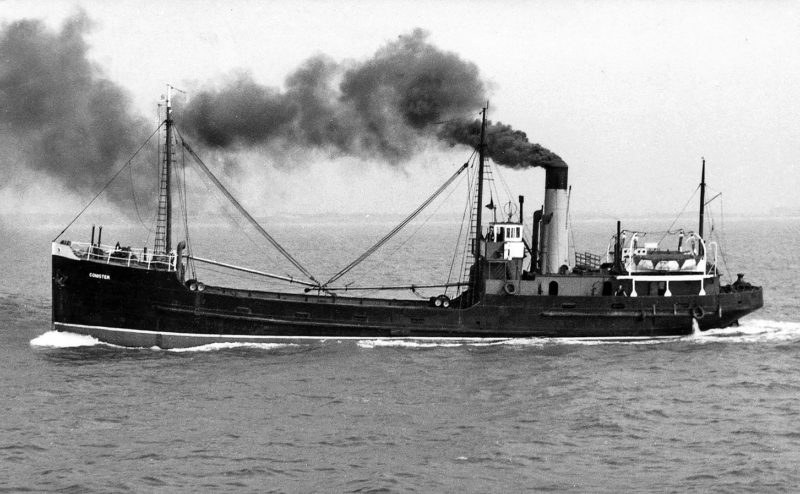
The passenger ferry Caesarea of 1,512grt and built in 1910 for the London and South West Railway Company was salved and purchased by the company on 27th November 1923 after she had stranded on the Jersey coastline four months earlier. She was renamed Manx Maid and was a triple screw turbine steamer that survived World War II but was broken up at Barrow in 1950. Two further railway passenger steamers were purchased on 11th May 1928 as Duke of Cornwall and the twin funnelled Antrim, and built for Heysham or Fleetwood to Belfast service, and renamed Rushen Castle and Ramsey Town respectively. The twin funnelled Victoria of 1,641grt and built in 1907 was also purchased at this time from the South East and Chatham Railway Company and not renamed, but was converted to oil firng in 1932. In that year of 1932, the company owned 16 vessels with 13 passenger ships and 3 cargo ships. The latter were Conister411/21, Cushag 223/08 and Peveril 798/29 as the first cargo ship specially built by the company and which could also carry 12 passengers. The passenger ships were:-
- Ben-my-Chree (4)of 2,586 grt and built in1927 by Cammell, Laird
- King Orry (3) of 1,877 grt and built in 1913by Cammell, Laird
- Lady of Mann of 3,104 grt and built in 1930by Vickers Armstrong Ltd.
- Manx Maid of 1,512 grt and built in 1910 by Cammell, Laird
- Manx man of 2,030 grt and built in 1904 by Vickers
- Mona (4) of 1,219 grt and built in 1907 by Fairfields
- Mona’s Isle (5) of 1,688grt and built in 1905 by Denny
- Peel Castle of 1,474 grt and built in 1894 by Denny
- Ramsey Town of 2,083 grt and built in 1904by John Brown
- Rushen Castle of 1,724 grt and built in 1898by Vickers Snaefell (4)of 1,713 grt and built in 1906 by Fairfields
- Tynwald (3)of 937 grt and built in 1891 by Fairfields
- Victoria of 1,641 grt and built in 1907 by Denny
- Viking of 1,957 grt and built in 1905 by Armstrong, Whitworth
Lady of Mann was completed in 1930 as the Centenary Ship of the company and served the company for 41 years in both a white hull and a black hull livery, arriving for breaking up at Dalmuir with a black hull on the last day of 1971. She had accommodation for two thousand passengers and was similar to Ben-my-Chree (4) of 1927 with glass enclosed promenade and shade decks. Lady of Mann was launched at Barrow on 4th March 1930by the Duchess of Atholl and who also had the title of Lady of Mann. She replaced Viking on the Douglas to Fleetwood service and her trials speed of 22.79 knots was often exceeded in service. Company records indicate that she carried around 3.8 million passengers in her long career as the flagship and steamed around 400,000 miles on her twin screw turbine propulsion. Company ships the Red Ensign with the Three Legs of Man symbol until 1933, but in that year the company was ordered by the Admiralty to cease the practice.
The twin screw passenger steamer Mona’s Queen (3) was launched in April 1934 by Cammell Laird, her design featured an elliptical stern and straight stem. She was given a white hull in line with the company policy of giving the flagship Lady of Mann and Ben-my-Chree (4) in 1932/33 white hulls and green boot topping. A service speed of 21knots was maintained by two sets of Parsons geared turbines. The black hulled passenger ferries Fenella (2) and Tynwald (4) were launched on the same day of 16th December 1936 from the Barrow yard of Vickers Armstrong Ltd. They were the first ships in the fleet to have cruiser sterns and raked stems, and a noticeable feature was their funnel tops which sloped upwards towards the back. They had service speeds of 21 knots and at full speed could turn in four lengths with engines fully reversed in 90 seconds.

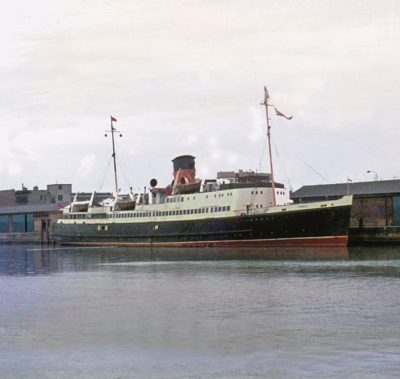
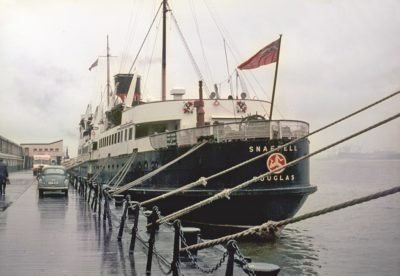
WORLD WAR II
A fleet of sixteen passenger and cargo steamers was being traded on the outset of World War II on 3rd September 1939, with three cargo ships and thirteen passenger steamers. Manxman was requisitioned immediately for trooping service, and was converted into a radar training ship in 1942 and renamed Caduceus. Manx Maid became the Fleet Air Arm tender Bruce in 1942. The remainder of the passenger fleet also saw Government service, except for Snaefell (4) and Rushen Castle, which maintained a Douglas to Fleetwood service for most of the war. The call for Cross Channel steamers to evacuate the British Expeditionary Force from Dunkirk towards the end of May 1940 saw eight of the fleet rescue 24,700 troops or 7% of the total that made it back to England. However, the price to the company was high with three ships lost, and Mona’s Queen (3)was the first to go during the morning of 29th May when she was mined and sunk off Dunkirk with the loss of two dozen of her crew. Capt. Cubbin had his ship Fenella (2)sink in port beneath him when she was bombed around 1700 hours on 29th May at the East Mole in Dunkirk, while King Orry(3) was bombed during the afternoon of the29th May but remained afloat until 0200hours of the next day when she sank off the beaches. The anchor of Mona’s Queen (3)was later raised as part of the 70th anniversary commemoration of Operation Dynamoat Dunkirk and is sited at Kallow Point in Port St. Mary on the island as a memorial to the ship’s crew who took part in the evacuation.
Tynwald (4) was converted into an anti-aircraft escort ship with many high angle guns fitted to her decks, but she was mined and sunk when entering Bougie harbour in Africa on 12th November 1942. The high service speed of the fleet of 21 knots kept the remainder of the ships safe from torpedoes, with release from Government serv-ice in 1946. Snaefell (4) was sent to the breakers during that year, and the returning Viking, Mona’s Isle (4), Victoria, Lady of Mann and Ben-my-Chree (4) were given long refits after their strenuous war service.
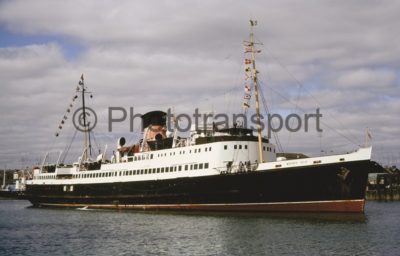
Post-War Years
The Liverpool to Douglas main route from the Pierhead passenger berth and the cargo berth in Coburg Dock became the only year round service in the 1950s, with seasonal services from Heysham on Thursdays only and seasonal services only from Fleetwood, Ardrossan and Belfast, and Dublin. The Belfast ship usually went south around the island and the Calf of Man rather than north around the Point of Ayre to Douglas. John F.Crellin OBE was Chairman of the company in the late 1950s with half of the Board of six directors living on the island and half near Liverpool or in Lancashire. A summer only service from Llandudno was introduced in 1961 to Douglas after the North Wales Steamship Company Ltd. sold one of its ships and then went into liquidation in November 1962. The Isle of Man Steam Packet then took over the Liverpool to Llandudno season-al service, with three excursions per week and with a cruise from Llandudno rounding the Great Ormes Head towards Anglesey in the afternoon before the ship turned to return to Liverpool. Liverpool to Llandudno services ended in 1980 with the service from Llandudno north to Douglas ending two years later.
The reason for the decline of company services in post-war years was the shift in the pattern of British summer holidays to the sunshine of Spain and Mediterranean by air package tours. Alarmingly, a quarter of a mil-lion visitors to the Isle of Man in 1970 came by air travel. The wonderful short evening sightseeing tours from Douglas to the Calf of Man and the occasional Round the Island voyage had to be discontinued in 1972/73due to lack of support from people on holiday on the island. Special charters for a very short summer period continued to operate for thetwo week TT period and for other occasional private charters from Stranraer, Ardrossan until 1985, Workington, Barrow, Preston, Fleetwood, and Holyhead. A slight revival in the fortunes of the Isle of Man Steam Packet Company occurred during the 1970s with passenger numbers increasing in the seas onto around 370,000 from 330,000 or less during the 1960s.
The post-war passengers were carried in style on the pre-war Lady of Mann and the equally lovely Ben-my-Chree (4) until 1971and 1965 respectively, but mainly on a series of post-war ‘Six Sisters’, although none of them were identical in their details. A of these ‘sisters’ was completed during1946/48 as King Orry (4), Tynwald (5), Snaefell (5) and Mona’s Queen (4), with two further ‘sisters’ completed during the 1950s as Mona’s Isle (5) and Manxman (2). They had cowl topped funnels and carried around 2,165 to 2,390 passengers with hull dimensions of overall length 344.0 feet, moulded beam of 47.2 feet and depth of 17.2 feet with a gross tonnage of 2,490 with a crew of 68.They were powered by steam turbines driving twin screws, and they differed in details such as number of cabins, internal bars, lounges, dining rooms, as well as boiler pressures and lifeboat gravity davit types.

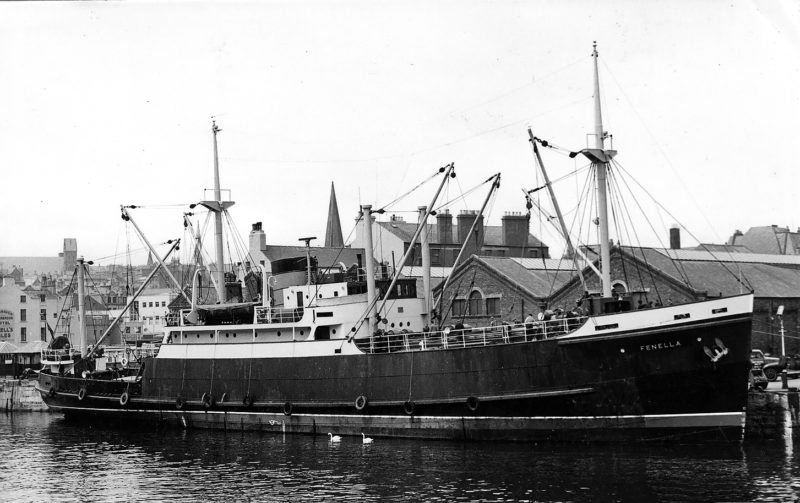
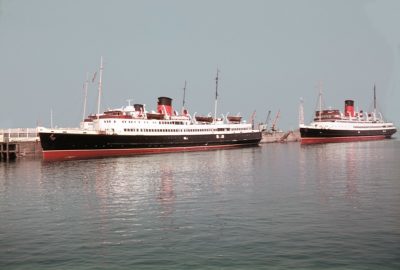
Manxman had the longest career of the sextet, being sold after her last Fleetwood to Douglas sailing on 15th August 1982, and moored at Preston for use as a restaurant and nightclub, followed by a long period in a dry dock next to the entrance to the river Hull at Hull, before finally being towed to Sunderland and moored on the outside of the Pallion Shipbuilding Hall until water began to seep into her hull and she was then moved inside the Hall to be broken up in 2012. The services to the Isle of Man were thus exclusively ro-ro after 1982. King Orry (4) was broken up at Strood in 1979, Mona’s Queen(4) was sold in 1962 to Chandris of Greece and renamed Carina and then was rebuilt for further use as the cruise ship Fiesta, being broken up at Perama in 1981, while Tynwald(4) was scrapped at Aviles in Spain in 1975,and Snaefell (5) was broken up at Blyth in1978, and Mona’s Isle (5) was broken up in Holland in late 1980. Mona’s Isle operated a special June 1980 Round the Island cruise in connection with the 150th anniversary of the company, and was then withdrawn from service in September 1980.
Cargo services were provided by the old Conister of 411grt and built in 1921 until1965, and the new Fenella (3) of 1,019grt completed in 1951 by Ailsa Shipbuilding Company yard at Troon, and Peveril (3) of 1,048grt in 1963 again from the Ailsa yard. They used a Liverpool berth on the north east corner of Hornby Dock in Liverpool, with Peveril (3) running alongside the new coaster Ramsey of 446grt completed in 1965 by the Ailsa yard at Troon. Ramsey had a speed often knots from a six cylinder British Polar diesel engine, and her crew of eighteen were home ported at Ramsey but also used the Coffee Palace berth in Douglas. Fenella (3)was sold in January 1973 to Greek owners in Piraeus, while Ramsey was sold shortly after-wards and replaced by the container carrier Spaniel of 891grt, renamed as Conister (2).The latter had been built as Brentfield for the Zillah Shipping and Trading Co. Ltd. and converted into a container carrier in 1972,carrying 46 TEU of containers. Peveril (3) sailed away from Douglas after sale in August 1981 to Cypriot owners, together with the sale of Conister (2), and they were replaced in 1981 by the ro-ro cargo ship N.F.Jaguar.
Increasing numbers of visitors to the island in the early 1960s wished to bring their cars, and the first of four side loading ships carrying 750 passengers was completed in 1963 as Manx Maid (2) from the Cammell Laird yard at Birkenhead. The company used a unique spiral system of opposed ramps near the stern of the vessel for the loading and unloading of 80 to one hundred cars onto their car decks. The other trio of this quartet were Ben-my-Chree (5) of 1965, Mona’s Queen (5) of 1972 and Lady of Mann (2) of 1976, the first pair from the Birkenhead yard with steam turbine propulsion, and the last pair from the Ailsa Shipbuilding yard at Troon and fitted with Crossley – Pielstick diesel engines.

Manx Maid (2) was sold in 1985 and towed to Bristol for static use, she later returned to the Mersey and was broken up in1986 at Garston. Ben-my-Chree (5) was sold to American interests in 1985 for static use and was broken up at Santander in 1989.Mona’s Queen (5) had overwintered at Douglas during 1987/88, the first company vessel to do so for over thirty years, and was chartered by the French Post Office in September 1989 for use at Portsmouth in connection with the start of the Whitbread Round the World yacht race. She was withdrawn from service on 3rd September 1990 and laid up in the Vittoria Dock at Birkenhead, and sold in 1995 for further use in the Philippines as Mary the Queen with three company engineers on board for her long delivery voyage with bunkering stops at Valletta, Colombo and Singapore. She was later broken up at Alang in India in 2008.
Lady of Mann (2) underwent a £2.6million internal reconstruction to increase car capacity by thirty cars to 130 cars and provide modern passenger facilities for 64 berthed and 936 deck passengers during the winter of 1988/89. She was officially recommissioned at Douglas on 27th May 1989, and as well as her Irish Sea duties and deputising during other vessel refits, she also operated on charter to the Porto Santo Line in Madeira and also on several summer three month long charters to Acor Line in the Azores, the last during 2004, during her long career with the company. She flew the Portuguese flag during these charters, and even had a blue whale painted on the white part of her hull for Acor Line charters. She operated in the week before the May TT period during 2002 on a week of special cruises to Llandudno, Fleetwood and Whitehaven. She was sold in 2005 after a career of 29 years for further use as the Greek owned Panagia Soumela of SAOS Lines on the Lavrion to Limnos route, leaving the Mersey for the last time on 22nd October 2005, and was broken up at Aliaga in Turkey in 2011.
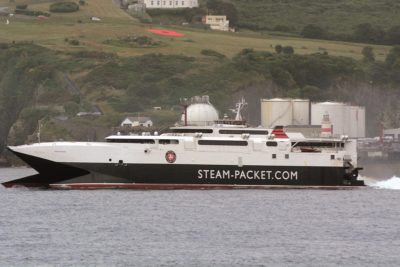
Manx Line/Sealink/Sea Containers Saga
Sealink was the final chapter of State owned cross Channel ferry services in 1964/65 with British Rail ferries then having red funnels with a logo of two opposed white arrows. By 1981, and in simple terms the Isle of Man Steam Packet Company had made a large financial loss, with a big drop in passenger numbers and a 40% drop in excursion numbers, and discontinued its Heysham service. Many company officers were made redundant and the winter passage times were extended by twenty minutes in order to lower the fuel bill. This led to a new entrant to the Isle of Man, Manx Line, formed in early 1978 by a consortium led by Douglas based Geoff Duke, former TT champion motorcyclist, in order to have a better twice daily service from Heysham using the Spanish twin funnelled ro-ro Monte Castillo of Aznar Line. She was chartered and renamed Manx Viking for the Heysham service and then operated continually for sixteen hours of every 24 hour period on two eight hour return passages. Control of Manx Line was then acquired by James Fisher and Sons Ltd. of Barrow in late November 1978, with 60% of the share capital of Manx Line then sold to Sealink and 40% retained by Fishers. The Isle of Man Steam Packet Company chartered the ro-ro N.F. Jaguar from P. & O. for a service between Liverpool and Douglas that began at the end of June 1981. She was then purchased by James Fisher & Sons Ltd. in January 1983 and renamed Peveril (4) on charter to the Isle of Man Steam Packet Company. Douglas harbour was modernised and provided with two link spans, one for the Isle of Man Steam Packet Company and one for Sealink, purchased by Sea Containers for£66 million in July 1984. The two companies, Sealink and the Isle of Man Steam Packet Company, were now in direct competition. Sealink management then persuaded three of the most important freight customers of the Isle of Man Steam Packet Company to switch allegiance to Sealink.
Financial losses continued, despite cuts to services, by the Isle of Man Steam Packet Company in the two year period of 1984 and 1985. In 1985, Sealink U.K. Ltd. acquired40% of the Isle of Man Steam Packet Company, and announced that the stern loading Antrim Princess, built by Hawthorn, Leslie & Co. Ltd. in 1967 to carry 1,200 passengers and stern loading of cars, would replace Manx Viking. She was in fact chartered to the Isle of Man Steam Packet Company for the Douglas to Heysham service after the ‘merger’ with Sealink. Antrim Princess was renamed Tynwald (6) in April1986 after purchase by the company and repainted in Isle of Man Steam Packet colours. She made her last sailing on the Heysham to Douglas route on 18th February 1990 and was laid up in the Fal until sold during the following month to Agostino Lauro srl of Italy and renamed Lauro Express. She had run between late 1984 and early 1986 with the purchased former Townsend, Thoresen ferry Free Enterprise III, built by the Gusto Werfyard at Schiedam in 1966, renamed by the Isle of Man Steam Packet Company as Mona’s Isle (6) for the Heysham to Douglas service, but she suffered many technical problems. Passenger sailings to Liverpool were discontinued in 1985, although reinstated on an occasional basis in 1986.
In 1987, the Sealink shareholding in the Isle of Man Steam Packet Company was increased to 42%, and later the Isle of Man Steam Packet Company became a wholly owned subsidiary of Sea Containers Ltd., headed by the businessman James Sherwood, who had pioneered fast craft operations. This led to two strikes by company personnel, one of two weeks duration during December 1986, and a much longer strike of seven weeks in early 1988 following a programme of redundancies and sackings, with 114 of the sacked personnel reinstated and only 47 being made redundant after the strike. Much later, in July 2003, the company was sold to£142 million to Montagu Private Equity, and was passed to the Australian Macquarie Bank in 2005 and then to the Spanish Banco Espirito Santo in April 2011. Finally, in May 2018, the long established Isle of Man Steam Packet Company with its unique identity and customs of the Isle of Man and its loya lManx population was purchased by the Isle of Man Government in a welcome move for the social needs of the island.
ISLE OF MAN STEAM PACKET COMPANY IN THE 1990s
The former French ferry Saint Eloi of 7,657grt, completed in February 1975 by the Cantieri Naviera di Pietra Ligure yard in Italy, was purchased in 1990 and renamed King Orry (6) with a white hull. This became a blue hull by 1997, and she had accommodation for one thousand passengers, with 952 unberthed and 48 berthed in a dozen cabins. She was a stern loader with two car decks for 170 cars or 430 lane metres of lorries and trailers. She had a service speed of 21.8 knots from twin sixteen cylinder Pielstick diesel engines of 14,600 bhp, and was sold after eight years of service in 1998 to Moby Lines of Italy and renamed Moby Love. King Orry(6) increased company loading figures in 1991 due to her better restaurant and other facilities. Ro-ro freight services were operated by the company at this period by Peveril(4) ex N.F. Jaguar, and purchased in 1992 at the end of her ten year charter to the company, for service until her sale in 2000, and by the chartered Belard of 5,801grt and completed in April 1979 as Mercandian Carrier IIfor Danish owners, becoming Belard in 1985.The company was cheered during the summer of 1991 with its share of passengers on the island well above 60% to the detriment of air travel to the island.
The Isle of Man Steam Packet Company operated a year round service from Douglas to Heysham, a seasonal service to Liverpool from March to September, a seasonal service to Birkenhead from November to March, a seasonal service to Belfast from April to September, and a seasonal service to Dublin from April to September. The year round twice daily service to Heysham and seasonal services to Birkenhead, Dublin and Belfast were handled by the flagship Ben-my-Chree(6) of 12,504grt, completed in July 1998 by the Van der Giessen yard at Krimpen in Holland. She has an overall length of 125.2 metres, moulded beam of 23.84 metres, depth of 14.3 metres and a loaded draft of 5.6 metres. She initially had accommodation for420 unberthed passengers and 80 berthed passengers in twenty cabins at the forward end of the vessel, increased to 630 passengers during a Spring 2004 refit. The car decks, one of which is hoistable, have a lane length of 1,235 metres and can hold 310 cars. She has a service speed of nineteen knots from twin four stroke nine cylinder MaK diesel engines of 11,746 bhp. She is a stern loader equipped with cargo heating coils with a hull built of part high tensile steel, with passengers having a choice of seating including aircraft style seats in the forward observation lounge.
Lady of Mann (2) began a Liverpool to Dublin service on 12th June 1997 crossing daily except on Wednesdays when fast craft SeaCat Isle of Man was used. This was the first regular service from Liverpool to Dublin since the Sealink service was axed in early 1990. Lady of Mann operated the Douglas to Fleetwood service on Wednesdays, and her usual pattern of operation was seasonal from Easter or May for day excursions prior to the busy two week TT race period in late May and early June, and then on scheduled summer services from Douglas to Liverpool, Fleetwood, Belfast and Dublin. King Orry (6) had, however, made two special return passages to Dun Laoghaire in October 1991 during an Irish Bank holiday weekend. Importantly, the uncertainty of the previous decade had been lifted for the company in 1994 when it received Government protection of its status as the sole provider of sea services to the island in return for guarantees on the level of scheduled passenger and freight services.
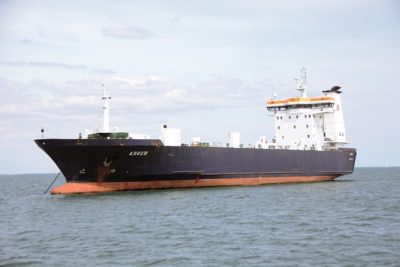
ISLE OF MAN FASTCRAFT
The Isle of Man Steam Packet Company has operated fastcraft services to the island since 28th June 1994, when the first SeaCat Isle of Man took only 94 minutes to Fleetwood from Douglas. Six fast wave piercers or monohulls have been used over two decades, with usually three in operation each year on summer seasonal services, two of which were later given the traditional company names of Snaefell (6) and Viking (2) in 2008. On 3rd February 2007, Sea Express 1 (formerly SeaCat Isle of Man) collided with the cargo ship Alaska Rainbow in heavy fog in the Mersey. None of her 294 passengers’ and crew were hurt, and the fast craft was moored at Liverpool Pier Head while water was being pumped from the engine room, a number of cars remained on board. She was later towed to the Cammell, Laird basin in Birkenhead where all remaining cars were offloaded. On14th March, 2007 she re-entered service and in December 2007 she was renamed Snaefell(6). Ben-my-Chree (6) deputised for her during her absence. The fastcraft Viking (2) and Snaefell (6), as well as passenger ro-ro Ben-my-Chree (6) were given new liveries in 2008 featuring prominent ‘Isle of Man’ words on both side of their hulls.
The current fastcraft Manannan was built in November 1998 in Tasmania by Incat and was initially used in Australian and New Zealand waters and on charter to the U.S.military. She was purchased on 19th May 2008 by the company for £20 million to replace the fastcraft Viking (2). She arrived at Douglas for the first time on 11th May 2009 after a £3 million refit at Portsmouth and entered service ten days later to operate a seasonal service from Douglas to Liverpool, Dublin and Belfast.
She was renamed Manannan after the Celtic god of the Irish Sea, and takes only two hours and 45 minutes to reach Douglas from Liverpool or Belfast. She was fitted with a removal mezzanine deck for motor-bikes in the winter of 2014/15 to increase capacity during the TT racing fortnight, and has a passenger capacity of 800 passengers and a vehicle capacity of 200. She has a variety of seating areas, including two cinema lounges, a large café bar area at the stern as well as the Coast to Coast café. She has dimensions of length overall of 96.0 metres, beam of 26.0 metres, and a draft of 4.0 metres. She has a company roundel showing the unique ‘Three Legs of Man’ symbol on each side of her hull just short of ‘midships on the white part of her hull.
POSTSCRIPT
A relief freight service is operated each year between Heysham and Douglas for the two week TT period by the ro-ro Arrow on charter from Seatruck Ferries. She was built as Varbola for the Estonian Shipping Company at Huelva in Spain in August 1998 and is of 7,606grt and 5,758 dwt and began on charter to the company on 28th April 2014. She also returns in August for another two week charter during the annual Manx Grand Prix motorbike event. Arrow then returns to her Seatruck duties or more probably another charter on the English Channel. The ManxLine ro-ro Manx Viking, which sailed away from the Douglas to Heysham route in 1988, after pioneering services in 1978 in opposition to the Isle of Man Steam Packet Company, was broken up in Canada during Millennium year.
Mark Woodward, Managing Director of the company at the Head Office of Imperial Buildings in Douglas, is optimistic for the future of passenger, ro-ro and fastcraft services, despite the latter suffering problems and much damage from debris in the Irish Sea, and a collision with the Victoria Pier in Douglas harbour caused by a system control failure.

The annual company traffic is currently 600,000 passengers and 170,000 cars and motorbikes, which has been maintained at around these figures since 2001 with 657,576 passengers carried in 2002. I wish the company well during the years running up to their bicentenary.



Comments
Sorry, comments are closed for this item